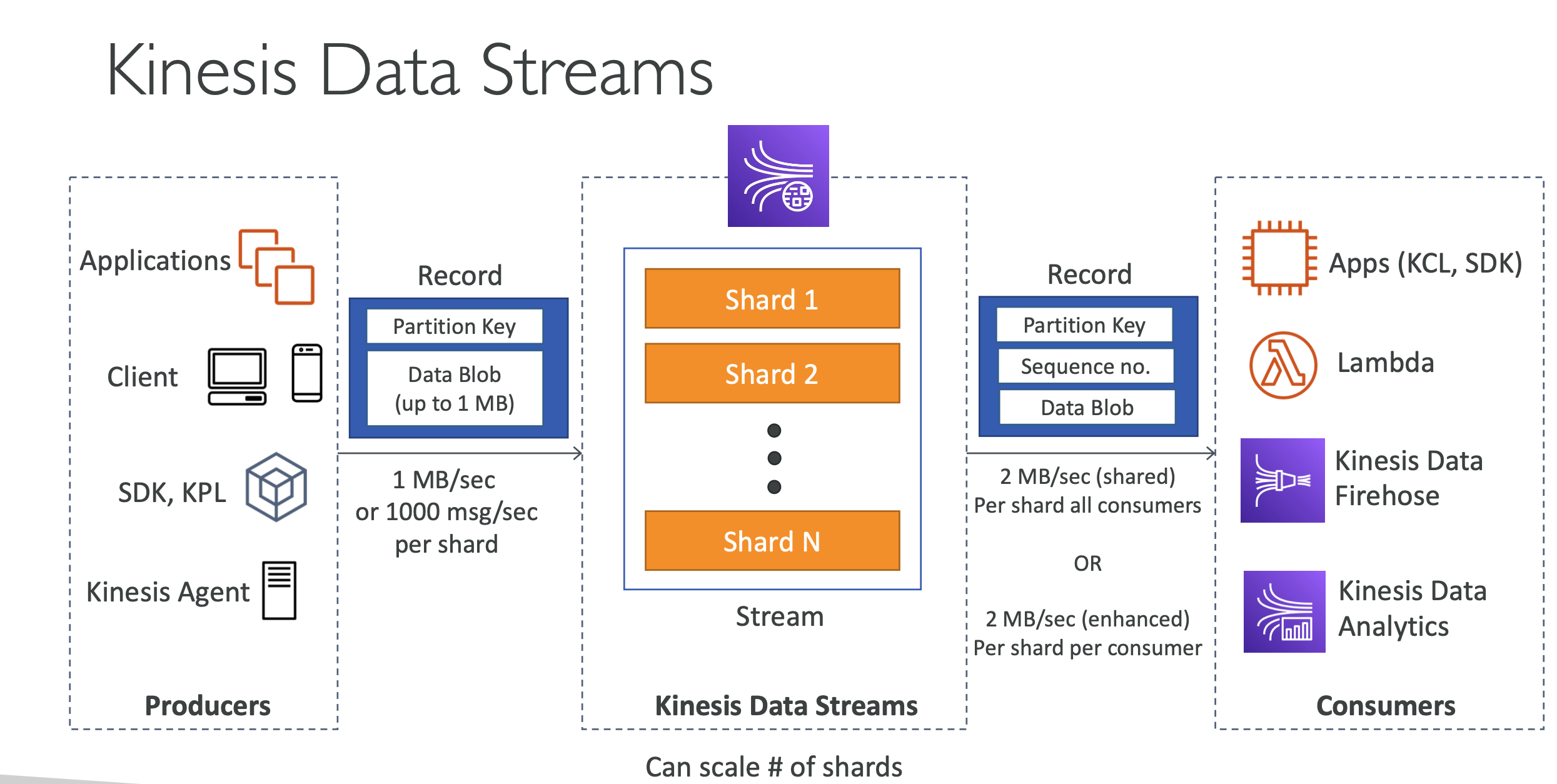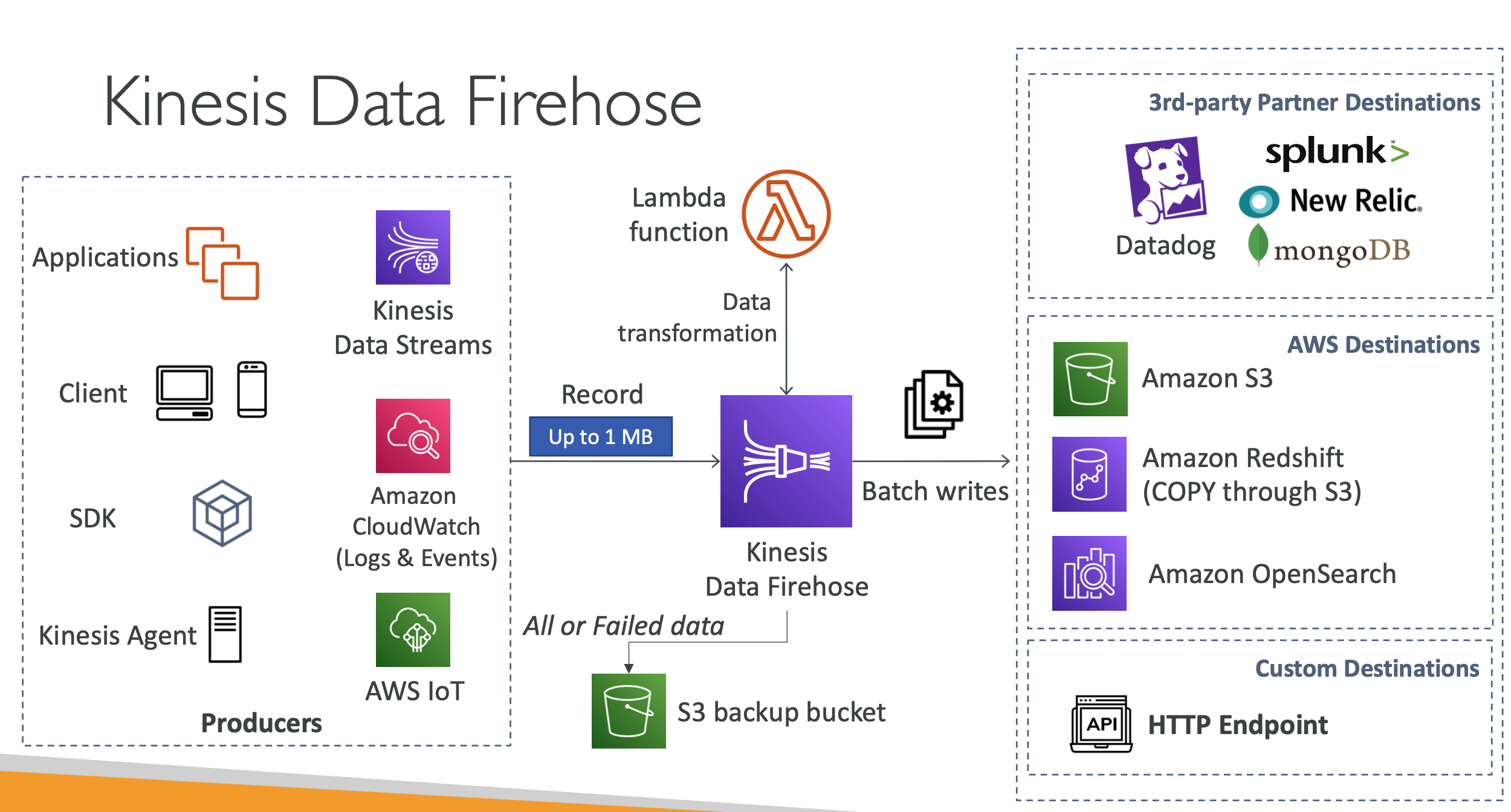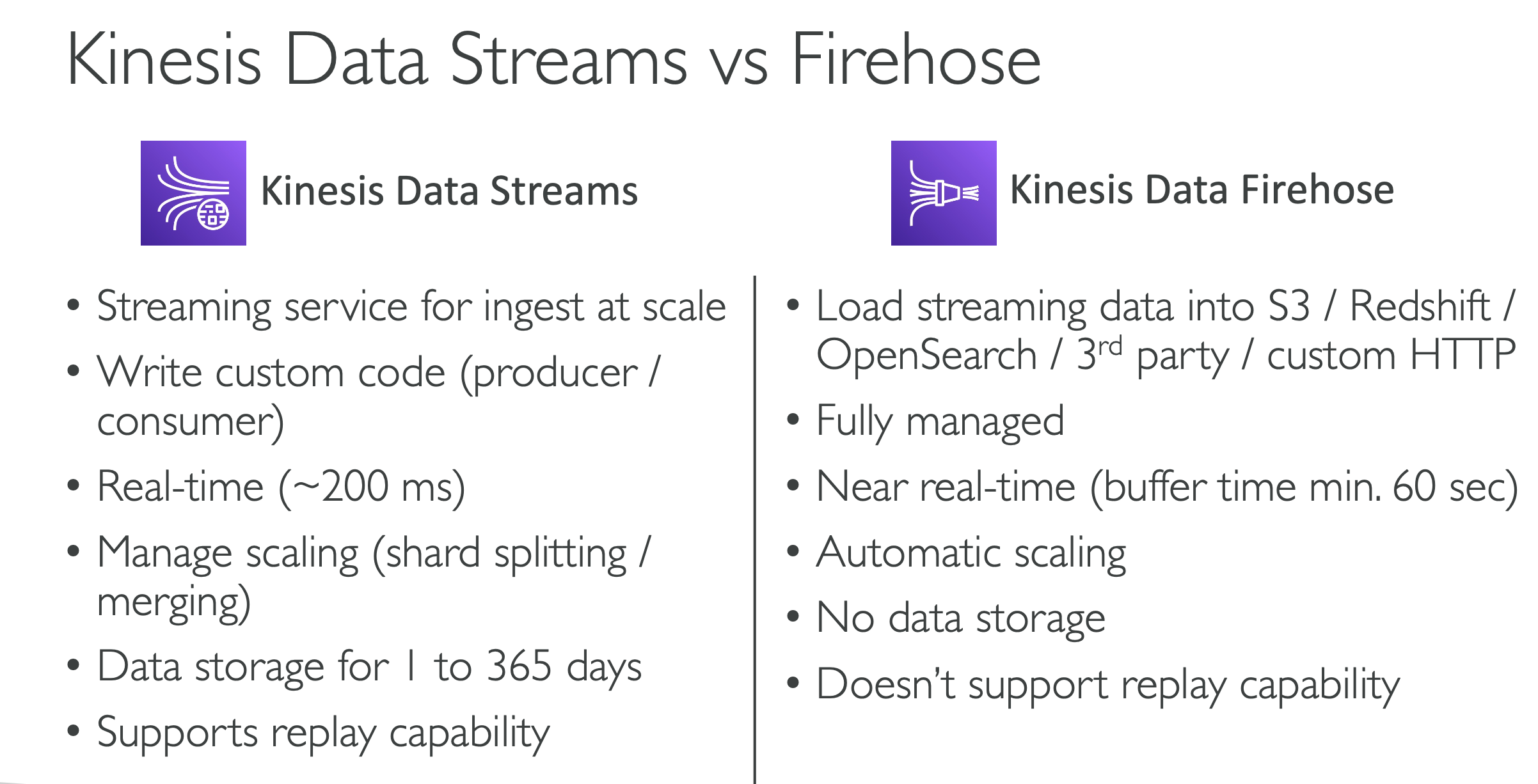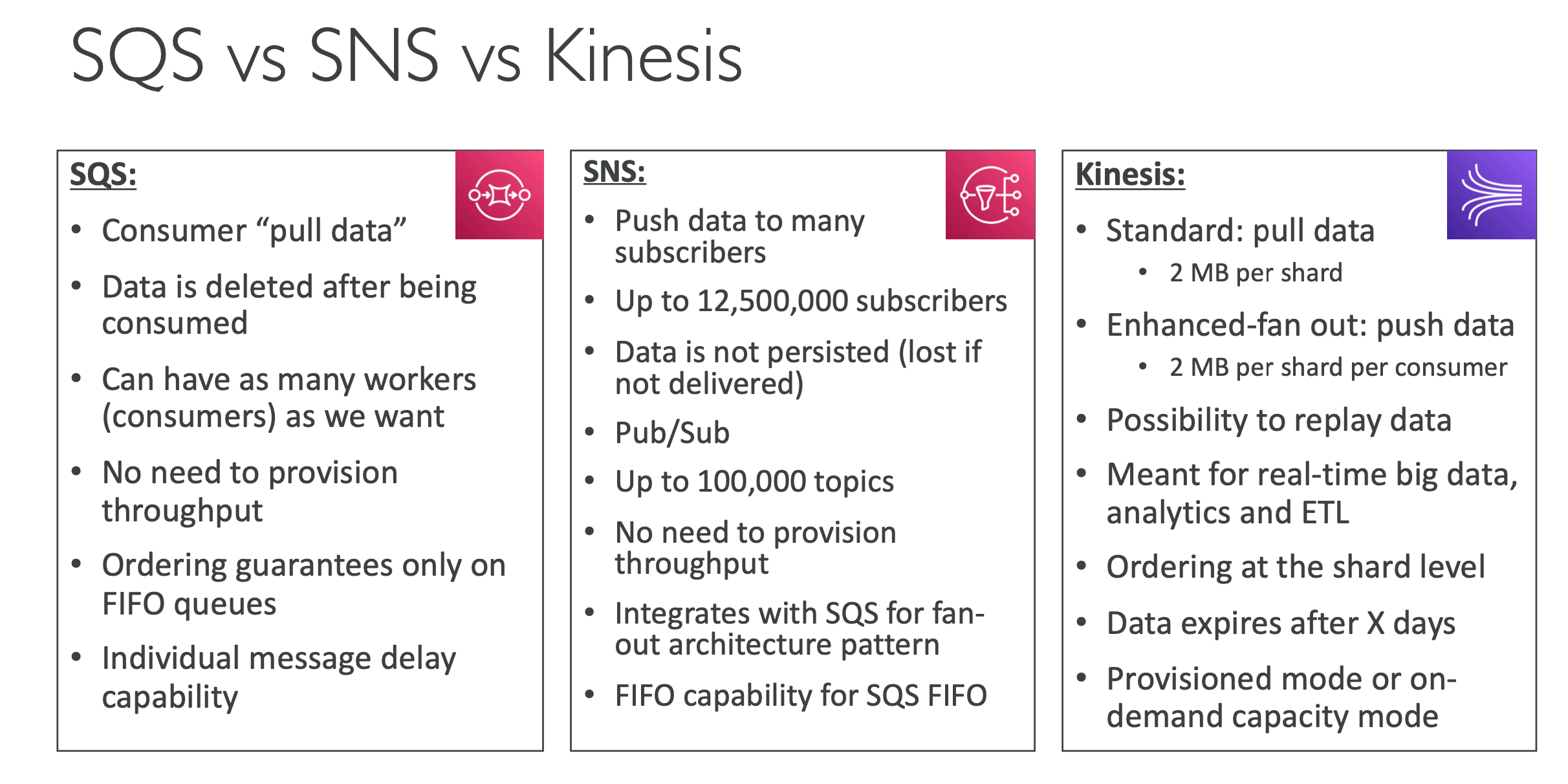SQS
Standard Queue
- Oldest offering (over 10 years old)
- fully managed service, used to decouple applications
- Attributes
- unlimited throughput, unlimited number of messages in queue
- default retention of messages: 4 days, 1 minutes ~ 14 days
- Low Latency (< 10ms on publish and receive)
- Limitation of 256KB per message sent
- can have duplicate messages (at least once delivery)
- can have out of order messages (best effort ordering)
- message is
persistedin SQS until a consumer deletes it - work with ASG (cloud-watch-metric queue length
ApproximateNumberOfMessages) - security
- encryption
- HTTPS (in-flight)
- KMS (at-rest)
- access controls - IAM Policies
- SQS Access Policies
- cross account access
- allow other services to write
- encryption
- Message Visibility Timeout
- After a message is polled by a consumer, it becomes invisible to other consumers
- by default, 30s
- If a message is not processed within the visibility timeout, it might be processed
twice - A consumer could call the
ChangeMessageVisibilityAPI to get more time
- Long Polling
- When a consumer requests messages from the queue, it can optionally “wait” for messages to arrive if there are none in the queue
- LongPolling decreases the number of API calls made to SQS while increasing the efficiency and reducing latency of your application
- The wait time can be between 1 sec to 20 sec
- Long polling can be enabled at the queue level or at the API level using
WaitTimeSeconds
- FIFO Queue
- Limited throughput: 300 msg/s, batching 3000 msg/s
- Exactly-once send capability (by removing duplicates)
- Messages are processed in order by the consumer
- SQS with ASG
- CloudWatch Metric - Queue Length
- CloudWatch Alarm
- Auto Scaling Group
SNS
- The “event producer” only sends message to one SNS topic
- As many “event receivers” (subscriptions) as we want to listen to the SNS topic notifications
- Each subscriber to the topic will get all the messages (supports message filtering)
- Up to 12,500,000 subscriptions per topic
- 100,000 topics limit
- Security
- Encryption
- IAM Policies
- SNS Access Policies
- Combine with SQS to achieve fan-out & persistent
- access policy
- cross-region delivery: works with SQS Queues in other Regions
- FIFO Topic
- Ordering by Message group ID
- Deduplication using a Deduplication ID or content based deduplication
- can have SQS Standard and FIFO queues as subscribers
- limited throughput (same as SQS FIFO)
- Message Filtering (JSON)
Kinesis
- Makes it easy to collect, process, and analyze streaming data in real-time
- Ingest real-time data such as: Application logs, Metrics, Website clickstreams, IoT telemetry data…
- Kinesis Data Streams: capture, process, and store data streams
- Kinesis Data Firehose: load data streams into AWS data stores
- Kinesis Data Analytics: analyze streaming-data with SQL or Apache
Flink - Kinesis Video Streams: capture, process, and store video streams
Data Streams

- Retention between 1 day to 365 days
- Ability to reprocess (replay) data
- Once data is inserted in Kinesis, it can’t be deleted (immutability)
- Data that shares the same partition goes to the same shard (ordering)
- Producers: AWS SDK, Kinesis Producer Library (KPL), Kinesis Agent
- Consumers:
- Write your own: Kinesis Client Library (KCL), AWS SDK
- Managed: AWS Lambda, Kinesis Data Firehose, Kinesis Data Analytics,
- Capacity Modes
- Provisioned mode
- each shard gets 1MB/s in (or 1000 records per seconds)
- each shard gets 2MB/s out
- On-demand mode
- default capacity provisioned (4MB/s or 4k records per second)
- scales automatically based on observed throughput peak during the last 30 days
- Provisioned mode
- Security
- IAM policies
- encryption in-flight https endpoint, at rest using KMS
- VPC Endpoints available
- Monitor API calls using CloudTrail
Data Firehose

- load streaming data to data-stores
- Pay for data going through Firehose
- Near Real Time
- 60 seconds latency minimum for non full batches
- Or minimum 1 MB of data at a time
- Supports many data formats, conversions, transformations, compression
- Supports custom data transformations using AWS Lambda
- Can send failed or all data to a backup S3 bucket

Comparison
Kinesis vs SQS ordering
Let’s assume 100 trucks, 5 kinesis shards, 1 SQS FIFO
- Kinesis Data Streams:
- On average you’ll have 20 trucks per shard
- Trucks will have their data ordered within each shard
- The maximum amount of consumers in parallel we can have is 5
- Can receive up to 5 MB/s of data
- SQS FIFO
- You only have one SQS FIFO queue
- You will have 100 Group ID
- You can have up to 100 Consumers (due to the 100 Group ID)
- You have up to 300 messages per second (or 3000 if using batching)

AmazonMQ
- SQS, SNS are “cloud-native” services: proprietary protocols from AWS
- Traditional applications running from on-premises may use open protocols such as: MQTT, AMQP, STOMP, OpenWire, WSS
- When migrating to the cloud, instead of re-engineering the application to use SQS and SNS, we can use Amazon MQ
- Amazon MQ is a managed message broker service for RabbitMQ, ActiveMQ
- Amazon MQ doesn’t “scale” as much as SQS / SNS
- Amazon MQ runs on servers, can run in Multi-AZ with failover
- Amazon MQ has both queue feature (~SQS) and topic features (~SNS)